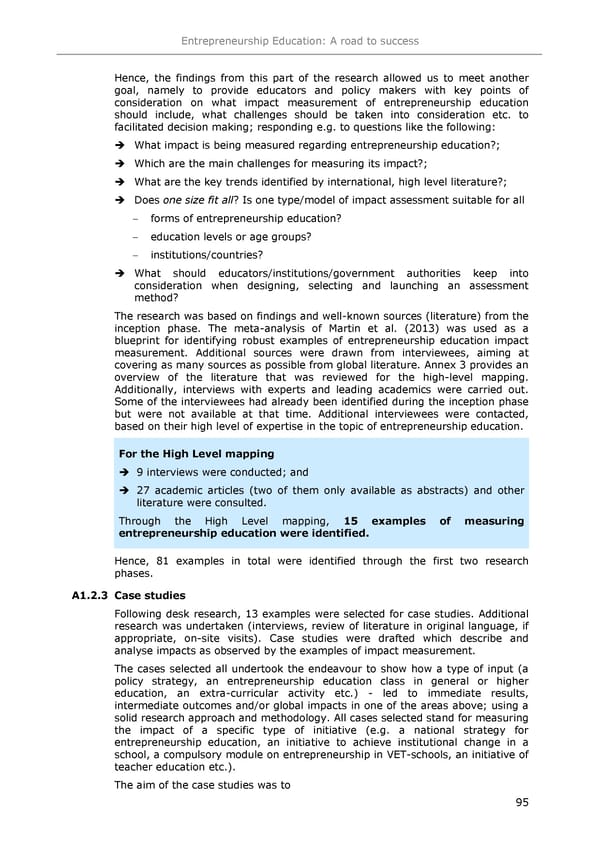Entrepreneurship Education: A road to success Hence, the findings from this part of the research allowed us to meet another goal, namely to provide educators and policy makers with key points of consideration on what impact measurement of entrepreneurship education should include, what challenges should be taken into consideration etc. to facilitated decision making; responding e.g. to questions like the following: What impact is being measured regarding entrepreneurship education?; Which are the main challenges for measuring its impact?; What are the key trends identified by international, high level literature?; Does one size fit all? Is one type/model of impact assessment suitable for all forms of entrepreneurship education? education levels or age groups? institutions/countries? What should educators/institutions/government authorities keep into consideration when designing, selecting and launching an assessment method? The research was based on findings and well-known sources (literature) from the inception phase. The meta-analysis of Martin et al. (2013) was used as a blueprint for identifying robust examples of entrepreneurship education impact measurement. Additional sources were drawn from interviewees, aiming at covering as many sources as possible from global literature. Annex 3 provides an overview of the literature that was reviewed for the high-level mapping. Additionally, interviews with experts and leading academics were carried out. Some of the interviewees had already been identified during the inception phase but were not available at that time. Additional interviewees were contacted, based on their high level of expertise in the topic of entrepreneurship education. For the High Level mapping 9 interviews were conducted; and 27 academic articles (two of them only available as abstracts) and other literature were consulted. Through the High Level mapping, 15 examples of measuring entrepreneurship education were identified. Hence, 81 examples in total were identified through the first two research phases. A1.2.3 Case studies Following desk research, 13 examples were selected for case studies. Additional research was undertaken (interviews, review of literature in original language, if appropriate, on-site visits). Case studies were drafted which describe and analyse impacts as observed by the examples of impact measurement. The cases selected all undertook the endeavour to show how a type of input (a policy strategy, an entrepreneurship education class in general or higher education, an extra-curricular activity etc.) - led to immediate results, intermediate outcomes and/or global impacts in one of the areas above; using a solid research approach and methodology. All cases selected stand for measuring the impact of a specific type of initiative (e.g. a national strategy for entrepreneurship education, an initiative to achieve institutional change in a school, a compulsory module on entrepreneurship in VET-schools, an initiative of teacher education etc.). The aim of the case studies was to 95
 Entrepreneurship Education Page 98 Page 100
Entrepreneurship Education Page 98 Page 100